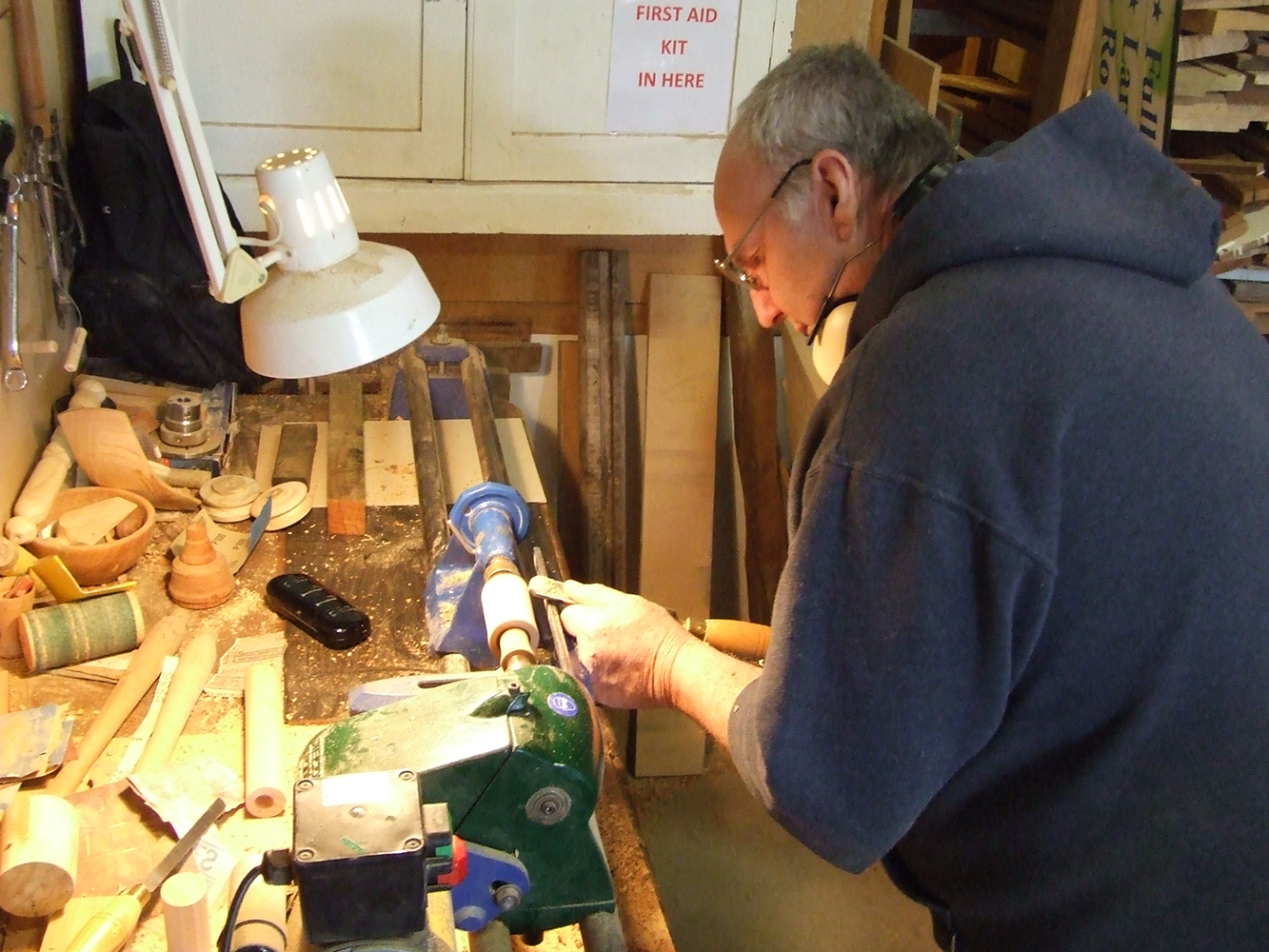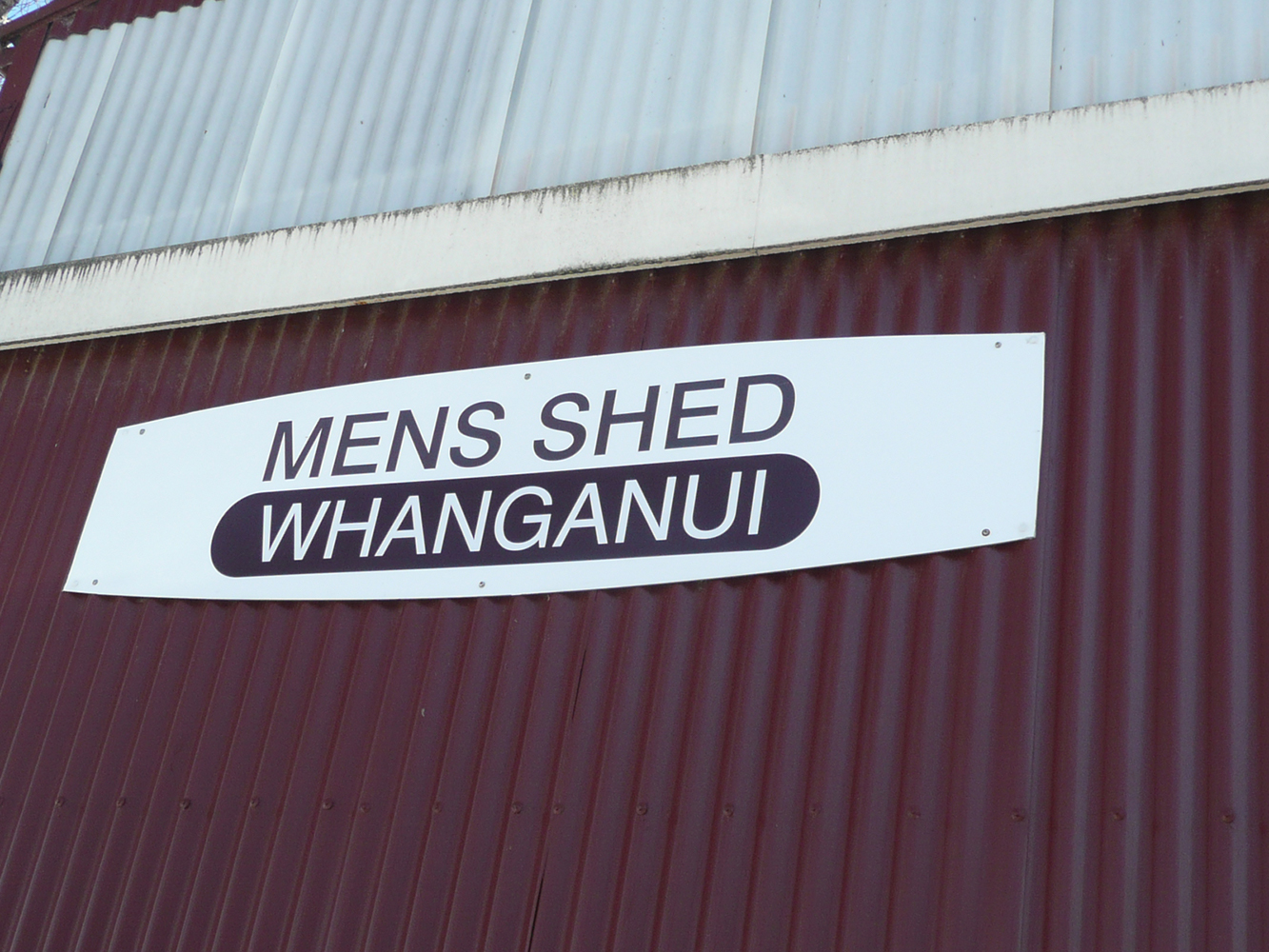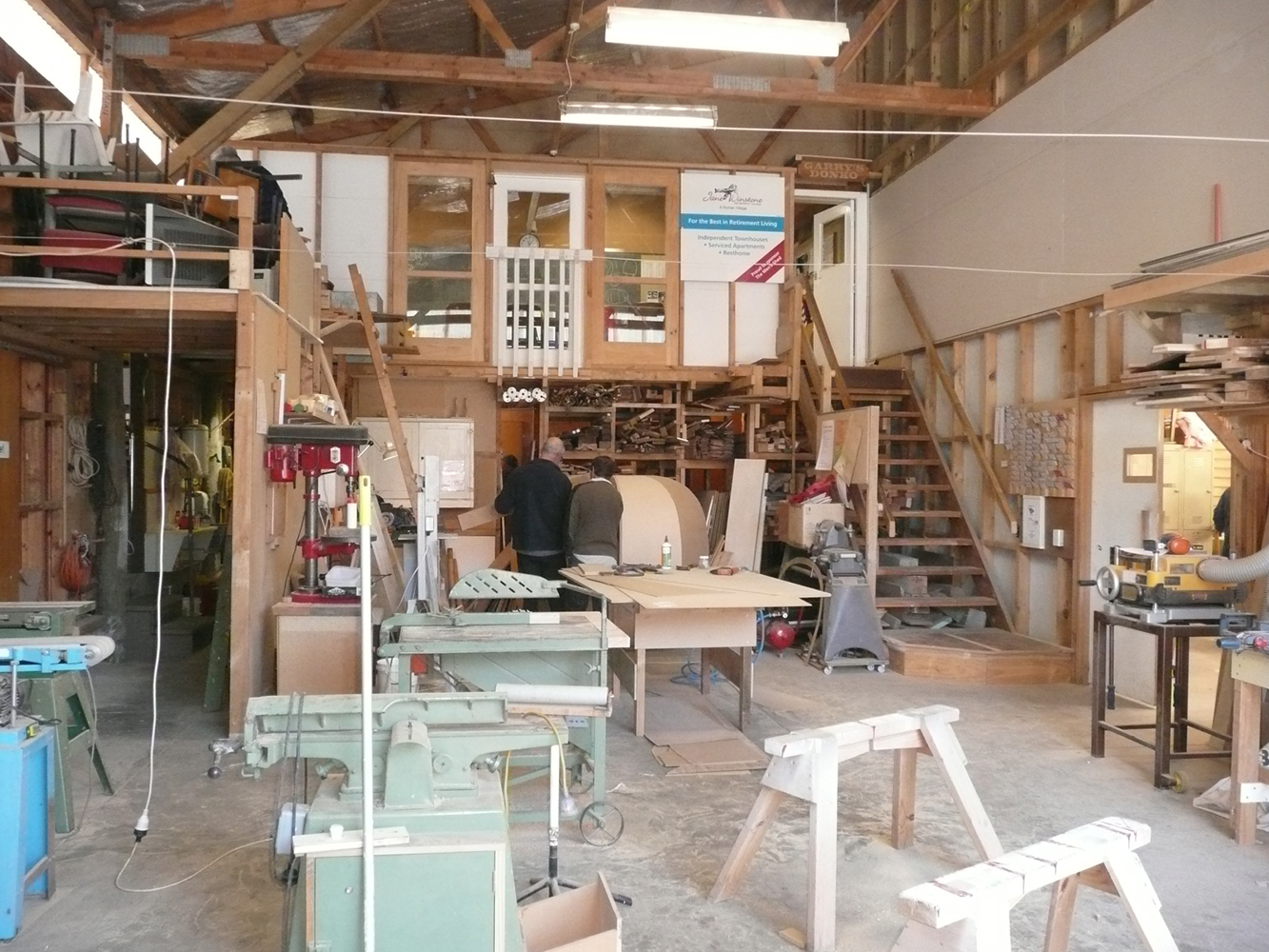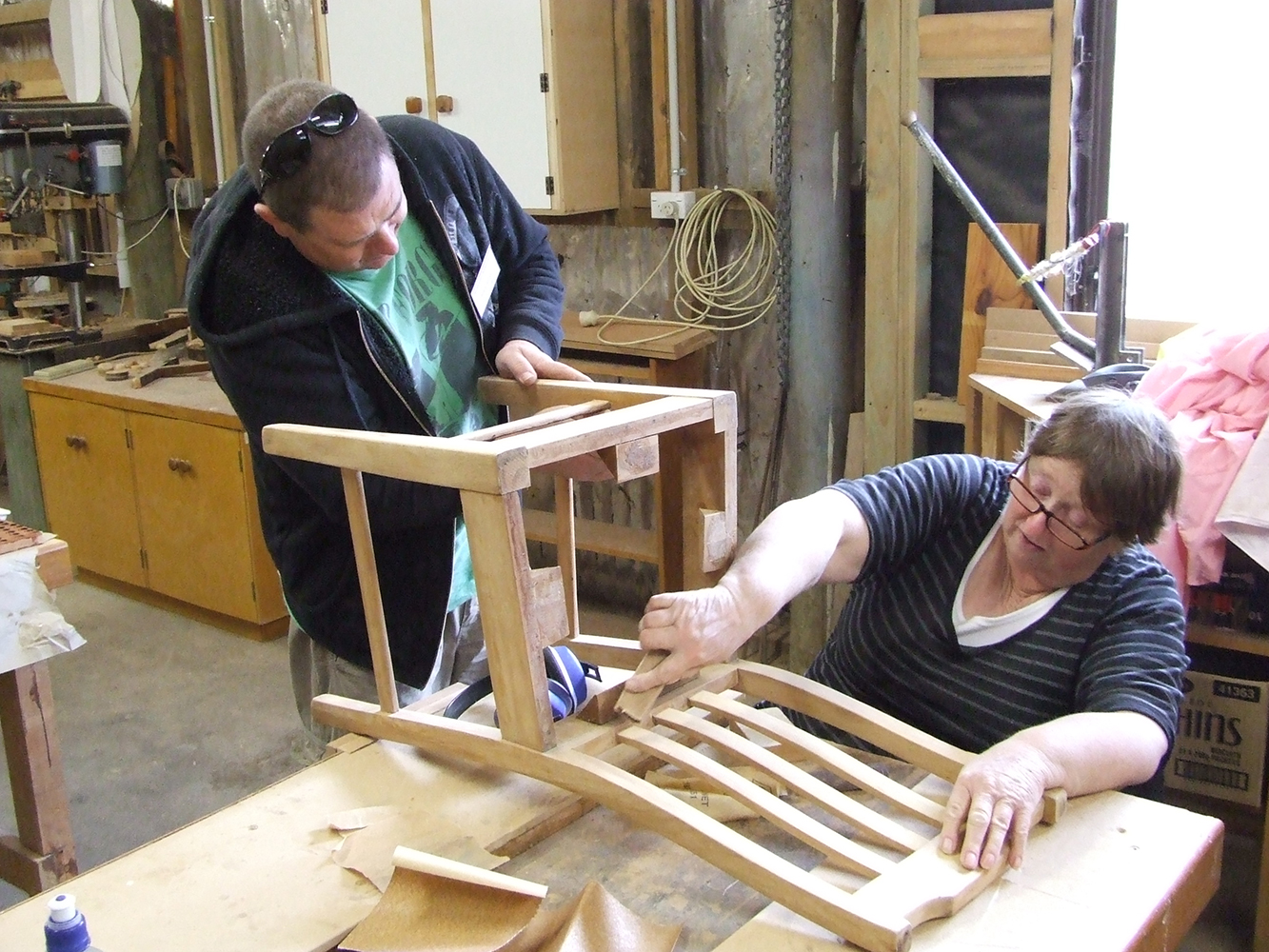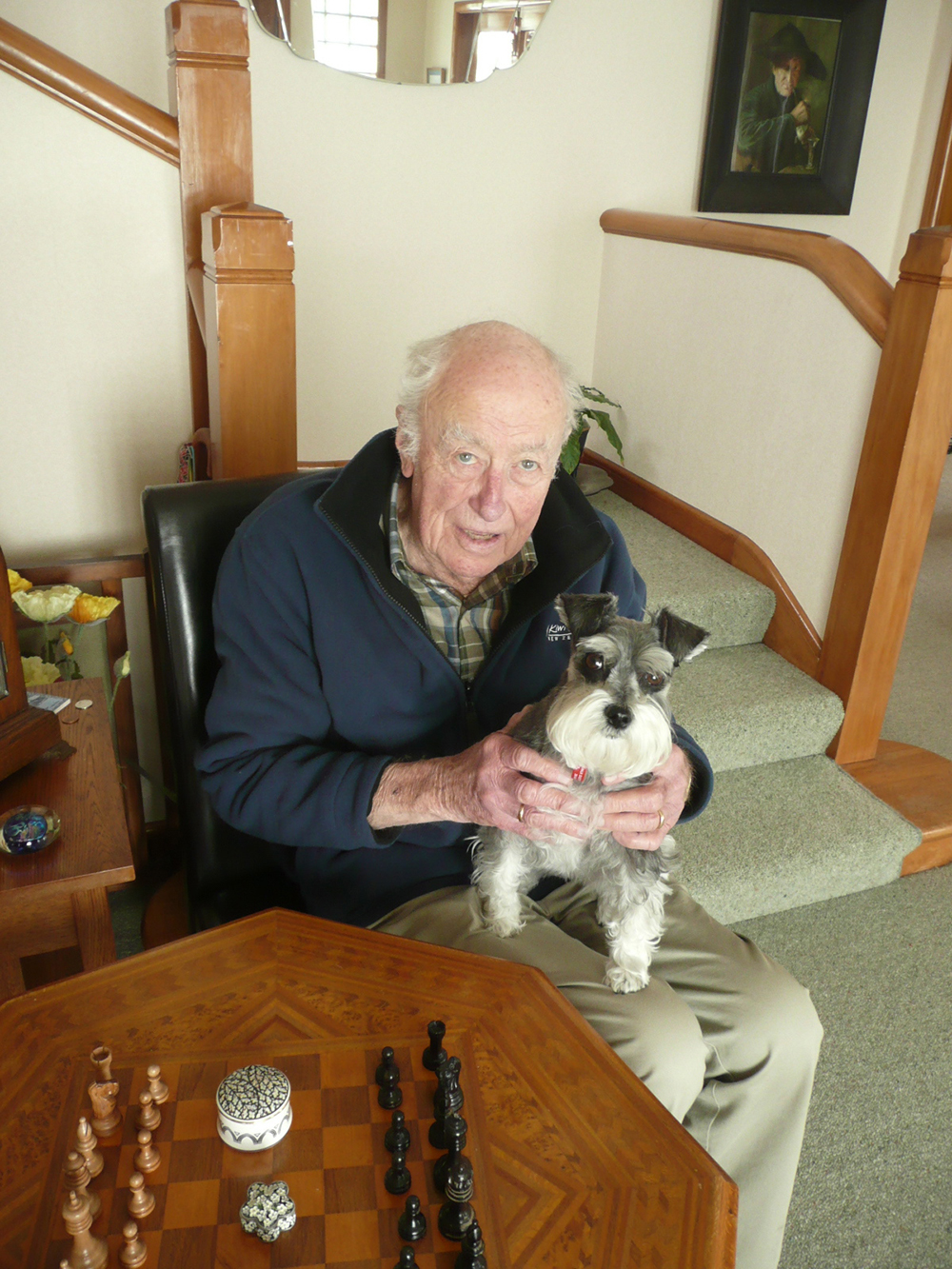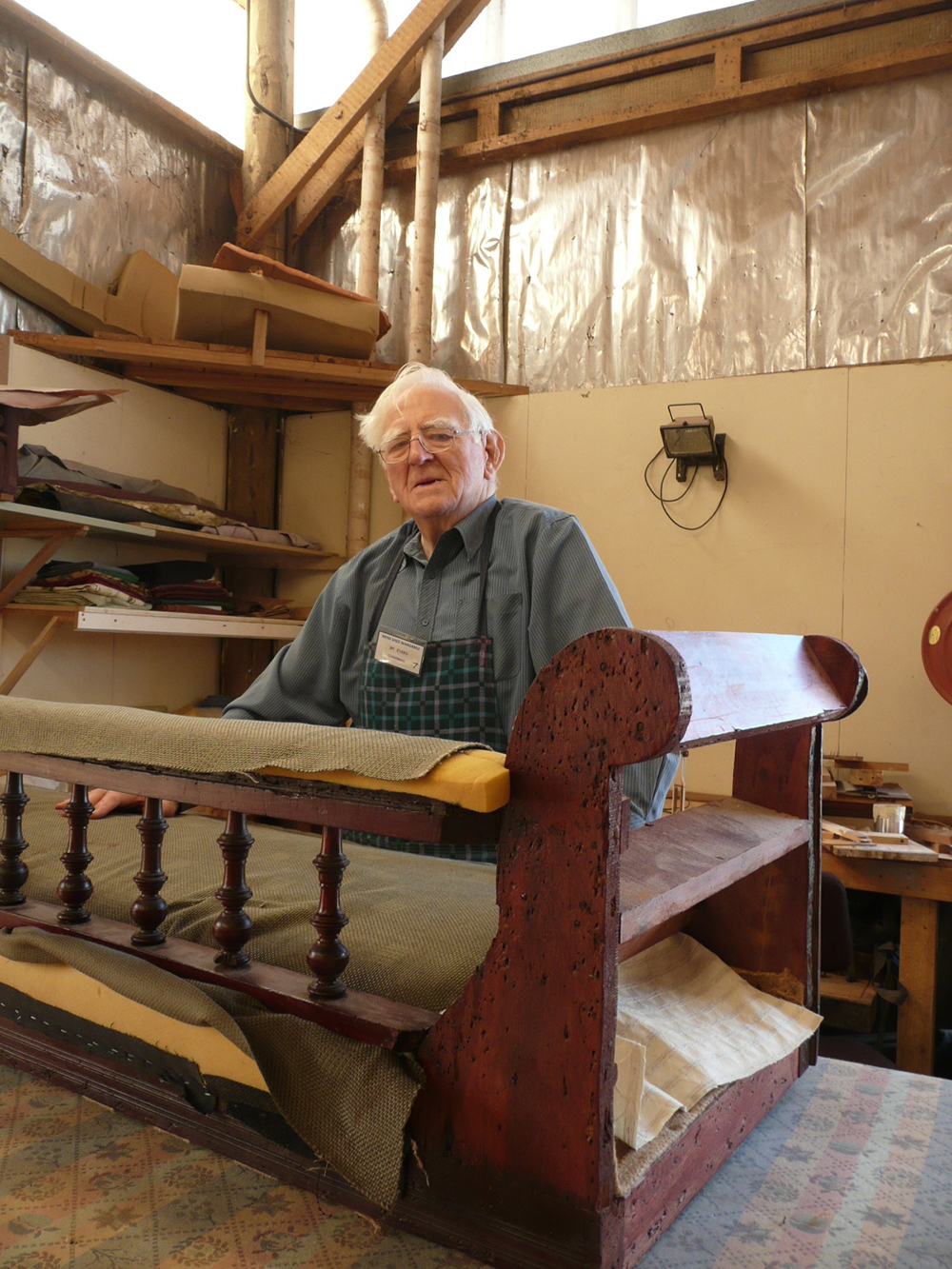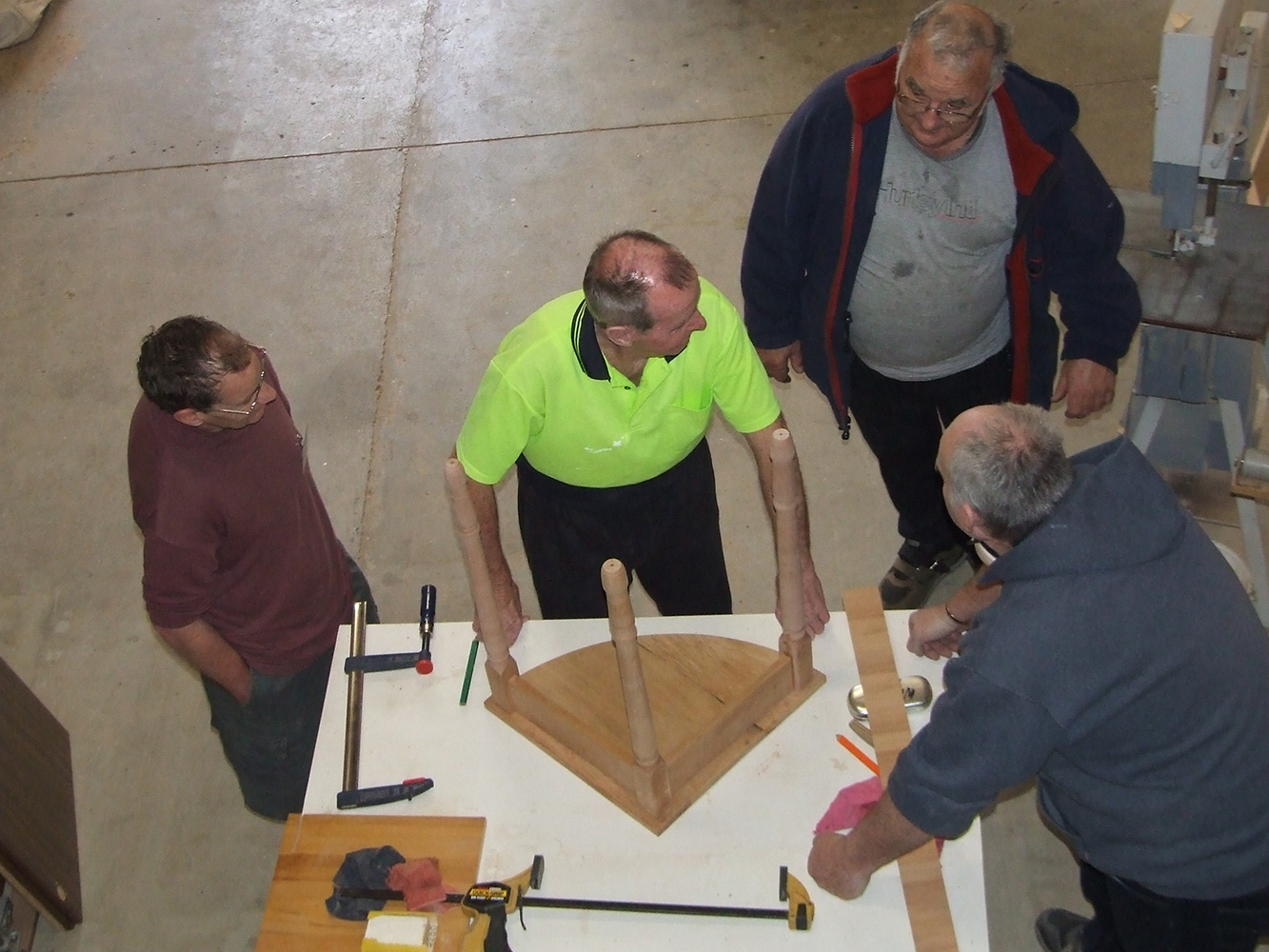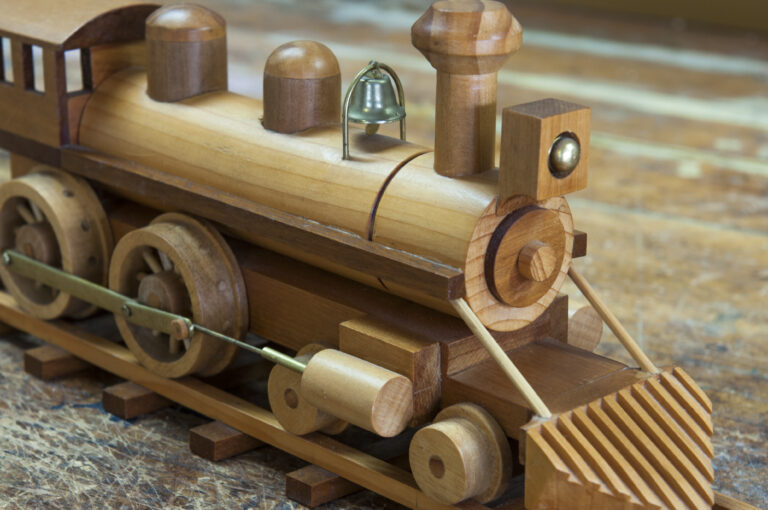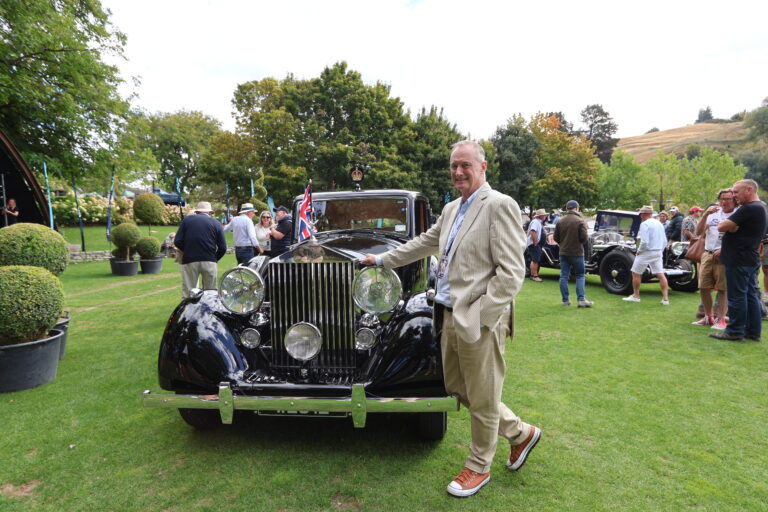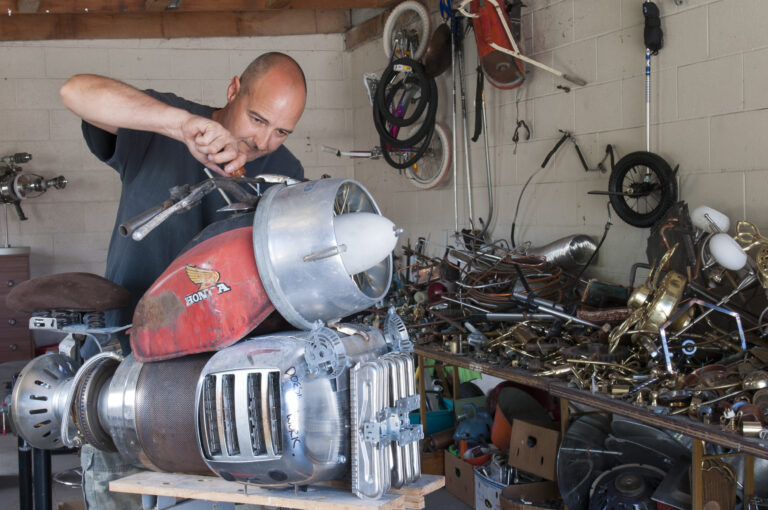Sounds of grinding, sanding and sawing at 292 Wicksteed Street announce that work is in full swing at the Whanganui Men’s Shed. Through the open door, a visitor can see men bending over machines, cutting and turning various lengths, shapes and colours of wood. There’s an airbrushing of dust and the scent of freshly worked timber. The machine shop is a high, cavernous space overlooked by a brightly lit mezzanine smoko room—the first project the men built together. A draw saw near the entrance is the most popular machine, says secretary Barry Boardman. He and Garth Stevenson show me around during a couple of visits. The shed is very well equipped with machinery thanks to the previous occupants, the former Wanganui Regional Community Polytechnic woodwork department. The Tupoho Whanau Trust rents the premises to the men’s shed at a very affordable $500 per month. When they heard about the Tupoho Whanau Trust, Barry met Trust chairman Ken Mair who said he knew just the place. “When we came in here it was full of rubbish right into the joists. But we thought this was a place where we could actually settle down,” Barry says. Ken made the men’s shed very welcome and they spent six months clearing it out and moving in. They opened on May 5, 2012. Founder George Bowers says he can’t speak too warmly of Ken. “He has been very supportive. The rental is much more reasonable than for other places we saw which the owners really wanted to sell and he doesn’t seem in any hurry to push it up. Here there is a feeling of stability.”
That “h”
While the spelling of Whanganui in their signage was a contentious issue for some, George Bowers says they agreed to the “h” out of gratitude to their landlords. In a recent edition of the local River City Press, historian and writer Murray Crawford is quoted as saying the ‘h’ debate is not a new one. “In December 3, 1876 the Evening Herald states: ‘We have received the first number of the Church Chronicle publication…we may remark that it would have been better if the Maori element had been sufficiently suppressed and not to have spelt Wanganui, ‘Whanganui’.” In 1902, mayor Alexander Hatrick suggested the letter “h” be reinstated in accordance with its original name and meaning. “Wanganui is not the name of our town,” declared the Mayor. When the Wellington Provincial Council agreed to change the name of the town from Petre in 1854 to Wanganui (the settlers had requested it), the Act referred to the “said town on the river Whanganui.”
Joining
People usually join the Whanganui Men’s Shed after hearing about it by wordof- mouth. Barry shows them around, they pay their subs—membership fees are currently $20 a year—and sign a membership form that includes a question about medical conditions and a standard disclaimer. Most of the members are getting on in years and health issues go with the territory, hence the telephone is reserved for emergencies. The big machines, essential instruments of serious sheddie practice, number a circular saw and band saw, a thicknesser planer, small lathe and buzzer and a couple of sanders. A multi-purpose machine combining wood lathe, saw bench, thicknesser and press belongs to a member who downsized and eventually intends to sell it. Beside the wood lathe, a corner table takes shape. Steve Manning stops turning one of the legs for a few seconds. “The last time I did any woodwork was 45 years ago at intermediate school. I’ve made five tables from totara and rimu since I joined a year ago,” he says. This men’s shed has a large stockpile of donated timber but Steve has done his dash with tables for now. Wally Bright and Steve are also turning salt-and-pepper shakers out of laminated woods while Brian Leathem watches how to do it.
Safety
Next door, sparks fly and crackle in the metalwork section. The welder and metal lathe are also there courtesy of the former polytechnic site. Garth has plans to make a larger wood lathe; he’ll make the components at home and supervise construction in the men’s shed. Health and safety rules are being written up. Supervisors, rostered on every Tuesday and Thursday when it’s open, induct new members into the use of machines. Members supply their own earmuffs and protective glasses. The main area of the second workshop is set up with three benches and a drill press. Tools hang from the walls; the donations from deceased estates and from members who are downsizing into smaller houses keep the men’s shed well supplied.
Leatherwork
The group just inherited $1000 worth of leatherwork tools and have a course in mind that could harness the skills of a saddle-making member. Garth has set up a grunty, 200-year-old leathersewing machine, part of his father’s antique collection. It has a needle like a crowbar and an oil trough that the linen thread runs through. Upholsterer and Whanganui Men’s Shed chairman, Jim Eyers is in demand as members take the opportunity to refurbish their furniture. Sharing skills is a major part of the men’s shed philosophy. Many of the 108 members are retired or semiretired tradesmen, mainly in the woodworking trades, and DIYers.
Women members
Wendy Gordon, one of the nine women members, sands down a kitchen chair. Her forte is patchwork quilting which she does at the church across the road. “I came over when I saw a group of them sitting outside one day and I asked, ‘Do you take women in? I’d like to learn some skills.’ I’ve always wanted to do my kitchen up.” She says it’s a privilege to be part of the group and no, she won’t be teaching patchwork quilting. “Get real,” she says. Wendy never makes cups of tea but she brings the occasional cake for her “precious boys.” Wendy comes from a farming background where “if something didn’t work you made it work. Don’t ask me how, but you made it work.” She has a shed at home and is learning the skills to operate her tools. “I can use a drop saw—things like that—but some of the stuff like skill saws I’ve brought down here to use.” Teaching Founder George Bowers has quite a track record in the central North Island community. Initially a teacher in Palmerston North, he became principal of a large primary school then worked in senior roles as an inspector with the Education Department until his compulsory retirement at the age of 60. That was the norm until gradually over 1992-2001 65 became the age to receive national superannuation. Retirement is now optional. George tutored literacy and instructed teaching English as a second language, which he hears is taught very successfully in conjunction with practical work at some men’s sheds. While he admits to having had an untidy bench rather than a shed, he can claim lineage in manual skills. His grandfather was proud of his English-trained cabinetmaking; he made the inlaid wood draught/chess table which sits by George and Peggy’s front door. His father, who really wanted to be a violinist and played in a silent movie orchestral group, was a master builder. “They’d come through the Depression and my grandfather pushed my father out to work; he didn’t go to secondary school. My dad was keen for me to get a decent education but he didn’t encourage me to become a builder. “One day I brought home a little chopping board we had to make at school. I thought it was quite good but my father put a finger on one corner and a finger on the other. It rocked, and he shook his head.” At another bench Les Cockburn is making two children’s armchairs. A retired public servant and DIYer, Les learned handyman skills from his electrician father. “I’ve downsized and I don’t have much room. There’s a lot of machinery here I wouldn’t have at home anyway,” Les says. He has made toys for the community and does home improvement projects through the men’s shed.
Purpose
Barry, previously a shipping manager for ICI and Rolls Royce, has acquired sheddie skills later in life and recently re-upholstered a chaise longue and a chair. He says the men’s shed gives him a purpose and the opportunity to learn new skills and socialise. His administrative skills are also handy. “In 1961 when I started at Rolls Royce I noticed a lot of people died shortly after retiring,” Barry says, something he was going to avoid. “I realise, now I’m getting older, that they’d go home and sit in their chairs. They had nothing else to do, they had no object, so they just died away.” Garth says it’s the fellowship and contact with other blokes that he comes there for. He finds being at home alone in his shed while his wife is still in paid work has limited appeal. Garth trained as a coachbuilder. He also worked as a topdresser and as a pipe organ builder both in New Zealand and America. There he was involved in the rebuild and refurbishment of the Salt Lake Tabernacle organ, one of the world’s largest. “Then I gravitated back into engineering in New Zealand and manufactured woodworking machinery for a few years.” The back of his large shed at home is equipped with engineering gear and the front is a mini-theatre where Garth has given two concerts on a Wurlitzer organ he refurbished. “It was originally designed to accompany silent movies so it’s like an orchestra with special effects—car horns, door bells, the sounds of surf and trains…it’s a lot of fun.”
Chaos
When the men’s shed moved into their premises Garth put order into some of the chaos. “All the equipment had been brought from storage [at a member’s farm in Fordell] and piled in the middle. People were getting confused and saying what’ll we do? So I said, Do you want me to set up a storeroom? and they said, Yes, go for it.” He itemised and stored the smaller tools and the many different sizes of screws and nails, nuts and bolts and a multitude of other materials in labelled boxes and set up a charging system for battery drills. Right now he’s off to a small island in Vanuatu to finish building a school and install a few more ram pumps so the villagers have water on tap. One of the men’s shed supervisors, John Wicks, was a builder in Waverley for 60 years before moving to the city. “I haven’t made anything for myself at the men’s shed, I’ve been helping everyone else because I’ve got a shed as big as this one in Waverley.” He is however in the process of selling and downsizing and the men’s shed has already inherited one or two things. A customwood coffin he made rests in a corner. John started making coffins years ago and brought the patterns for members to use. “We used to make the ends on an angle XX but I square it which is a darn sight easier to do,” John says.
Community
The men’s shed members put their skills to use for the community, making toys for Birthright, repairing the floats for the Christmas parade (a new fairytale float was taking shape under wraps), fixing garden tools, furniture and most things for people who pop by with a DIY problem. The men’s shed accepts donations for their work but they like to teach people DIY skills. A child’s walking aid was an unusual need for which they modified an old trolley. “It needed a bit of weight on the front and swivel wheels. It worked brilliantly,” Garth says. When the Wanganui Events Trust needed a lectern for the Cooks Gardens function centre, joiner Watty Watson stepped up and made one from 2000-year-old swamp maire. The maire, from a farm in Taumarunui, fell during the Taupo eruption. At intermission 13 sheddies gather around the long table in the tearooms. News and repartee bounce around. “It’s like a cage full of budgies, particularly at smoko time,” Barry says. “Working here helps people to sit down and talk because they’re involved in whatever project is being done in the shed. There’s always somebody available to help.” He recalls the party the men organised for Christmas 2010. “We invited wives and partners and they expected to walk into this shed as it was, quite messy to say the least. Well, they got a surprise because it was all nicely decorated with Christmas decorations and lights and the girls said they couldn’t have done a better job themselves.” The Whanganui Men’s Shed is a genuine success story. You also get the feeling that gender and other politics could be mellowing as men and women realise that it’s not just girls who can do anything.

